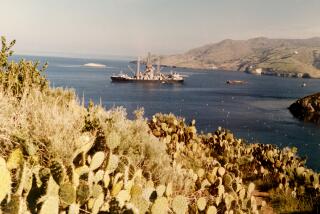U.S. Firm Hired to Retrieve Bodies of Sub Crew
- Share via
MOSCOW — Russia signed a high-risk, high-profile contract Monday with Halliburton Co., the Dallas-based energy services giant formerly headed by GOP vice presidential candidate Dick Cheney, to retrieve the bodies of sailors who died aboard the sunken Kursk nuclear submarine.
The agreement, in which Halliburton’s Norwegian affiliate will send a diving platform, diving bell and deep-sea divers to the accident site off the northern Russian port of Severomorsk this fall, improbably links two of the summer’s biggest news stories: the U.S. presidential election and the futile effort to rescue the submarine’s 118-man crew.
In Russia, the U.S. connection to Halliburton was given far less notice than the question of whether the salvage operation is possible or even necessary.
Russian navy officials have said that most crew members were probably killed instantly and that many of their bodies are likely to have been burned or destroyed. Moreover, even many of the crew’s family members have asked the government to leave the bodies buried at sea--according to naval tradition--and use the money to assist survivors.
“Let the submarine be their temporary tomb, as a time-honored sailors’ custom has it, until everything is ready to raise the whole ship together with the crew,” 78 relatives of the dead sailors said last week in a letter to President Vladimir V. Putin.
The government has been resolute about retrieving the bodies, perhaps because Putin personally made the promise as part of his damage-control efforts. The president was savaged at home and abroad for remaining on vacation during the bungled rescue operation in the Barents Sea.
Retired Rear Adm. Nikolai Mormul, who in 1972 helped raise a sunken sub, said the operation is likely to bring up no more than pieces of a few bodies.
“The problem is that his aides, navy commanders and government experts are simply afraid to tell [Putin] that he must take his word back,” Mormul said. “If they still go ahead with this operation, they will risk human lives, wasting a lot of money in the process. And in the end, no one will be happy or grateful for this stupid labor of Sisyphus.”
Halliburton’s Norwegian spokesman, Birger Haraldseid, said the contract is for a two-stage operation: surveying the submarine’s wreckage using divers and remote-controlled cameras, then retrieving the bodies. The surveying work will be done exclusively by Halliburton’s Norwegian and British divers and could provide new clues about the cause of the disaster.
During the retrieval, two Russian divers will work with a Halliburton diver, who will support them from a diving bell. Holes are to be drilled at various points along the hull, and one Russian diver will enter while the other supports him from outside the opening. Russians have been adamant that for security reasons, only Russian divers will be permitted inside the damaged vessel.
Haraldseid said Halliburton’s mobile diving platform Regalia will leave its home port of Bergen in the next few days and arrive off Severomorsk about 10 days later. He said the diving operations will probably take place around the clock in eight-hour shifts.
Russian and Halliburton officials declined to name the value of the contract, but it is likely to be more than the $9 million that Russian officials reportedly wanted to pay, and less than the $20 million that another Norwegian firm was reportedly demanding.
Halliburton officials said they could not estimate how long the operation will take, in part because it will depend on weather conditions. Igor Spassky, head of the Rubin design bureau that built the Kursk, told a news conference in St. Petersburg that the contract covers the months of October and November. Spassky said the bureau will now begin negotiating with foreign companies over a separate contract for raising the submarine wreckage to the surface, an operation planned for the spring.
The Kursk--one of the largest and finest nuclear submarines in Russia’s fleet--sank under mysterious circumstances Aug. 12. Two blasts were heard at the time of the accident--Russians say the sub probably collided with another vessel, perhaps a North Atlantic Treaty Organization submarine, while Western experts say it is more likely that a torpedo or other weapon exploded on board.
Cheney, the former Defense secretary, was Halliburton’s chief executive. He received a controversial $33-million retirement package after he resigned to run for vice president.
*
Sergei L. Loiko of The Times’ Moscow Bureau contributed to this report.
More to Read
Sign up for Essential California
The most important California stories and recommendations in your inbox every morning.
You may occasionally receive promotional content from the Los Angeles Times.











